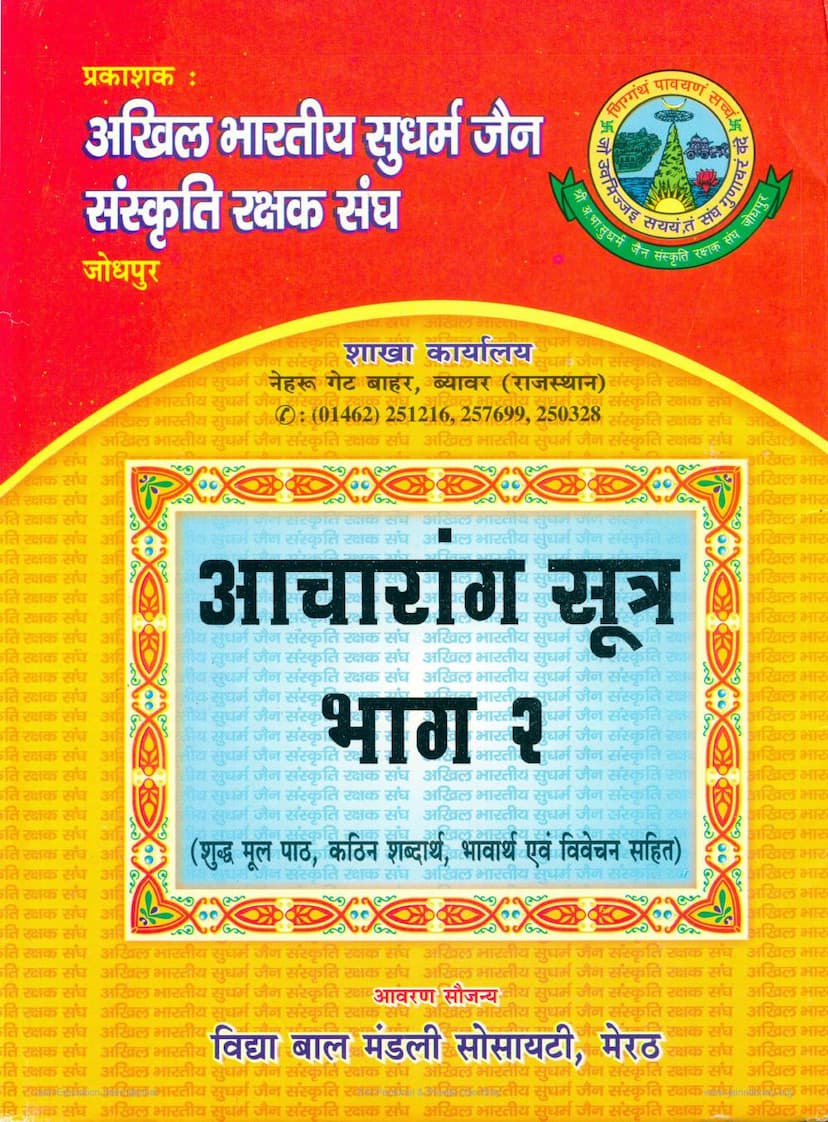Acharang Sutra Part 02
Added to library: September 1, 2025

Summary
This document is the second part of the Acharanga Sutra, titled "Acharanga Sutra Part 02" by Nemichand Banthiya and Parasmal Chandaliya, published by Akhil Bharatiya Sudharm Jain Sanskruti Rakshak Sangh. The catalog link is provided as jainqq.org/explore/004185/1.
The document is intended for private and personal use only.
Key aspects covered in the initial pages (1-9) include:
- Publisher Information: It details the publisher as Shri Akhil Bharatiya Sudharm Jain Sanskriti Rakshak Sangh, based in Jodhpur, with a branch office in Beawar. Contact information and fax numbers are provided.
- Book Details: It's identified as the 88th gem in the Shri Akhil Bharatiya Sudharm Jain Sanskriti Rakshak Sangh's literature series. The book is the second part of the Acharya Sutra, specifically the Second Shrutaskandha, containing the original text, difficult word meanings, interpretations, and discussions.
- Editors and Translators: Nemichand Banthiya and Parasmal Chandaliya are listed as editors.
- Sponsorship: Seth Jasvantlal Bhai Shah of Mumbai is acknowledged as the financial supporter for the publication.
- Distribution Points: Several locations are listed where the book can be obtained, including branches in Jodhpur, Beawar, Manmad, Mumbai, Malegaon, Delhi, Ahmedabad, Buldana, Bhilwara, Indore, Meerut, Chennai, and Kota.
- Publication Details: It's noted as the fourth edition, published in November 2006, corresponding to Vira Samvat 2532 and Vikram Samvat 2063.
- Introduction/Foreword: The "Nivedan" section emphasizes the importance of scriptures in any religion, particularly in Jainism. It highlights that the preachings originate from the omniscient Tirthankaras and are compiled by Ganadharas. The text discusses the primacy of meaning over scripture, the two types of meaning (one originating from Tirthankaras and the other based on scripture), and the reasons for potential variations in interpretation by later acharyas due to their knowledge limitations or deliberate distortions.
- Acharanga Sutra Overview: It explains that the Acharanga Sutra, being part of the Anga-pravishta literature, is the first among the eleven Angas. Its subject matter is entirely related to 'Achar' (conduct or behavior), which is considered the foundation for spiritual progress and essential for the well-being and order of the monastic community (Sangha).
- Structure of Acharanga Sutra: The text outlines that the Acharanga Sutra has two Shrutaskandhas:
- First Shrutaskandha: Named 'Achar' or 'Brahmacharya', it contains nine studies (Adhyayanas) and 51 Udeshakas. The seventh study is reportedly missing. It describes the conduct of Jain monks (Shramana Achar) such as non-violence, self-control, victory over passions, detachment, and liberation.
- Second Shrutaskandha: Named 'Achar Choola', it elaborates on the conduct of monks related to their daily life, including alms-seeking (Bhikshachari), movement, dwelling, acceptable food and vessels (Aeshana), speech control, sensory restraint, and the great vows (Mahavratas).
- Definition of Achara: Referencing the Nandi Sutra, the text defines Achara as encompassing the conduct, practices, discipline, education, speech, non-speech, actions, and behavior of Jain monks (Nirgranthas). It's categorized into five types: Jnana (knowledge), Darshana (faith), Charitra (conduct), Tapas (austerity), and Virya (energy).
- Detailed Study and Udeshaka Counts: It provides a breakdown of the studies and Udeshakas in both Shrutaskandhas, totaling 25 studies and 85 Udeshakas.
- Language and Style: It notes that the first Shrutaskandha, with its philosophical discussions, uses a concise sutra style making it linguistically complex, while the second Shrutaskandha, with its emphasis on the practical aspects of ascetic life, is more explanatory and easier to understand.
- Publication History: The document mentions previous successful editions of the first Shrutaskandha and the current publication of the second Shrutaskandha, noting its widespread acceptance and continued demand.
- Aswapadhya (Prohibited Study times): Page 9 lists 32 reasons for avoiding scriptural study, categorized into 10 related to the sky, 10 related to the physical body, and others related to events like eclipses, royal events, and specific periods of the month.
The subsequent pages (10-178) delve into the detailed textual analysis of the First Adhyayana, "Pindeshana" (Alms-Seeking), from the Second Shrutaskandha. This section meticulously explains:
- The principles of mendicancy: What constitutes pure and impure (Aparasuya/Aneshaniya) food and how monks should approach householders for alms.
- Definitions of key terms: Prasuya (pure), Aeshaniya (acceptable), Ashana (solid food), Pana (drinkable food), Khadima (chewables), Swadima (flavor enhancers).
- The ten vital energies (Prana): Explaining the concept of life force in living beings.
- Types of begging: Describing different ways of earning one's livelihood.
- Specific prohibitions and guidelines: This is the most extensive part, detailing meticulous rules about what food items are permissible or forbidden, and under what conditions. Examples include:
- Avoiding food mixed with or contaminated by living beings (plants, seeds, insects, etc.).
- Rules regarding grains and other food items, including how they are processed (e.g., whether they have been winnowed, ground, or cooked).
- Detailed instructions on what constitutes pure and impure food based on the presence of living beings or improper preparation.
- The importance of taking food in seclusion to avoid attracting attention or causing inconvenience.
- Specific regulations about how monks should behave when entering a house for alms, interacting with the householder, and accepting the food.
- Discussions on various types of forbidden foods (e.g., those prepared with specific methods, those contaminated by certain substances, or those associated with specific festivals or rituals).
- The strict adherence to purity and the avoidance of any act that might cause harm to living beings, even while begging for alms.
The document seems to be a scholarly edition of the Acharanga Sutra, providing the original text alongside comprehensive explanations, making it a valuable resource for understanding Jain ascetic practices.